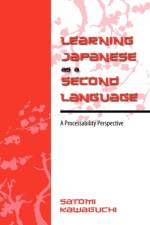von Satomi Kawaguchi
133,00 €
Language is central to human activity and is a fundamental expression of culture and a primary resource for social interaction. Learning the language of another culture is a very critical part of truly understanding the culture. This book examines the acquisition of Japanese as a second language. The ability to speak Japanese as a second language provides a great opportunity for opening a door into Japanese society and potentially gaining an in-depth experience of the Japanese culture and learning more about the Japanese people an experience one is unlikely to have without knowing the language. Given this, it is only natural to infer that language may be a key tool for breaking through intercultural boundaries. Language learning should therefore promote mutual understanding and, consequently, better and smoother communication in intercultural settings. Given the important implications of language on cultural understanding and improved communication in today s society, the process of second language acquisition deserves much attention. However, learning a second language is not usually an easy task. Attaining fluency in a language is one of the most complex skills a human being will ever acquire in their lifetime. When acquiring a first language as a child, the learning is rapid in the first four to five years of life; it takes place in a uniform manner and without much effort. Children around the world attain a high degree of success in their first language without instruction or corrective feedback. However, when it comes to the second, third, or any further subsequent language acquisition that begins after adolescence, such language learning requires much greater effort, with the ultimate attainment varying dramatically from one individual to the next from bare minimum to near-native independent of learner motivation and effort expended. Understanding second language (L2) attainment is thus a critical area of study. This study hypothesizes and tests the developmental stages of Japanese L2 verbal morphology and syntax within the framework of processability theory. It looks at four longitudinal studies (of one Portuguese as first language [L1], one French L1, and two English L1 learners of Japanese). Additionally, one cross-sectional study was undertaken to validate whether the results gained from the longitudinal studies could be generalized. Learning Japanese as a Second Language: A Processability Perspective makes a substantial contribution to second language acquisition (SLA) studies, especially for its discussion of speech processing involved in L2 sentence production and because it accounts for learning a language which is typologically distant from the native languages of the learners. The long-range perspective offered by data covering periods of up to three years is very unusual and thus highly valuable in the SLA context, where many studies are only cross-sectional or, at best, only cover a short time span. The longitudinal studies in this book are further buttressed by a cross-sectional study that supports generalizations from the findings. In addition, the author used original and inventive tasks to elicit data on structures such as passive and causative that are notoriously hard to elicit. The author also shows the various developmental stages and how these were used to measure the language development of both second language learners and bilingual speakers. This book will be an important reference for anyone working in the SLA and JSL fields, postgraduate students of Japanese and second language acquisition, and Japanese language professionals such as teachers of Japanese, JSL textbook writers, or English-Japanese translators.

